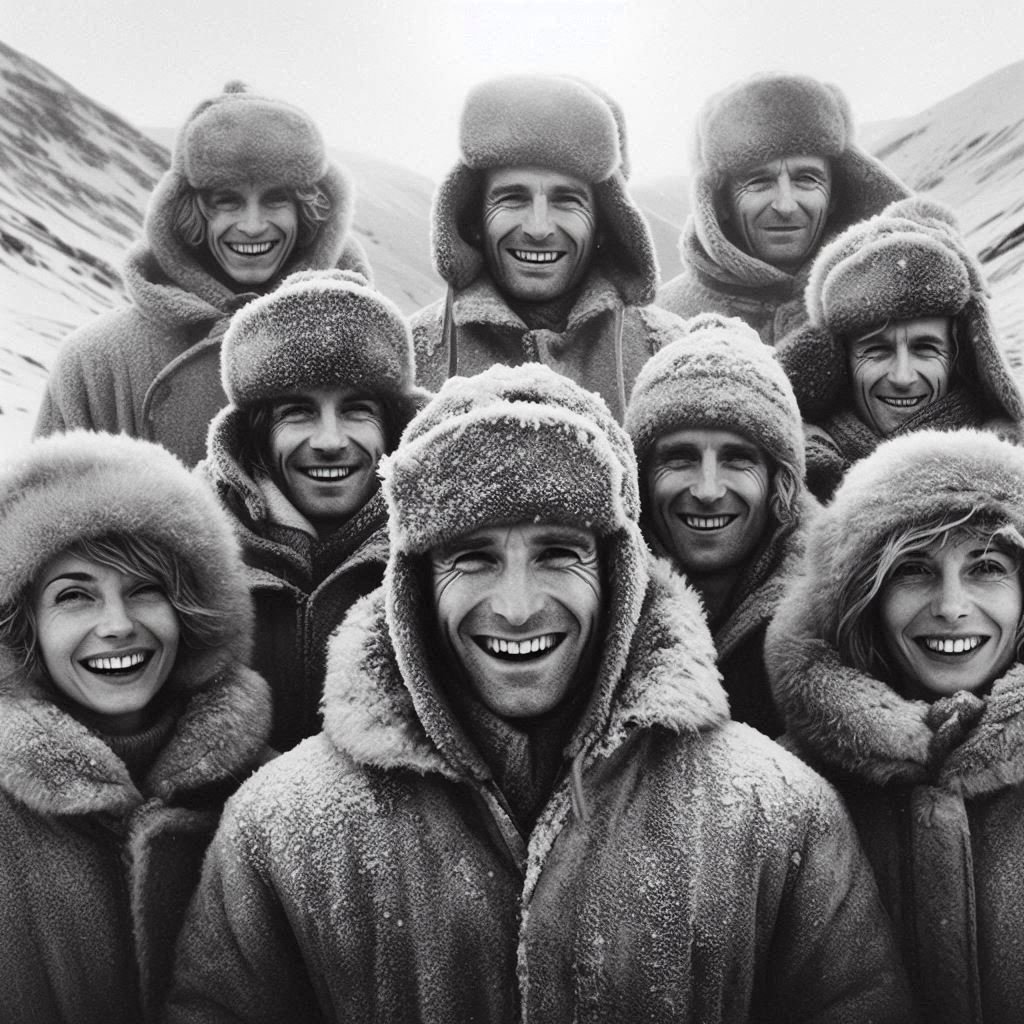Listen to “The Dyatlov Pass” on Spreaker.
Picture this:
It’s late January, 1959. You’re in the heart of Soviet Russia, trudging through the snowy wilderness of the Ural Mountains. It’s the kind of cold that makes your bones ache, where even your breath freezes mid-air. This place is so remote, so quiet, that it feels like the land itself is holding its breath. And right here, something happened—something so chilling, so bizarre, that over 60 years later, it still baffles scientists, investigators, and conspiracy theorists around the world.
This is the strange, dark, and downright terrifying story of the Dyatlov Pass Incident.
The Hikers
Our story starts with a group of ten skilled young people, most of them students at the Ural Polytechnic Institute. These weren’t your average weekend campers. These were elite hikers, the kind of people who thrived in extreme conditions. Their leader? A 23-year-old engineering student named Igor Dyatlov. Quiet, meticulous, respected. The kind of guy you wanted in charge if things went sideways.
Joining Igor were Zinaida Kolmogorova, Lyudmila Dubinina, Yuri Doroshenko, Yuri Krivonischenko, Alexander Kolevatov, Rustem Slobodin, Nikolai Thibeaux-Brignolles, and Semyon Zolotaryov. One final member, Yuri Yudin, would turn back early in the expedition due to health problems. That decision would save his life.
Their mission? A Category III trek—the toughest level at the time—through the northern Ural Mountains, ending at Mount Otorten. Completing it would earn them elite hiking certification. They knew the risks. But they had the gear, the experience, and the camaraderie to see it through.
Into the Cold
On January 25th, 1959, they boarded a train out of Sverdlovsk. Then a truck. Then skis. They carved their way deeper into a frozen, alien landscape. Snowdrifts. Wind that howled like a living thing. Temperatures that dipped to -30°C. But these hikers weren’t afraid.
By January 31st, they reached the edge of a highland area near a mountain the local Mansi people called Kholat Syakhl, which translates to… Dead Mountain.
They cached extra supplies in the forest below—a common practice to lighten their load—and started the final climb. Then, on February 1st, they made a curious decision. Instead of pushing through to a more sheltered area, they pitched their tent right on the eastern slope of Dead Mountain. Exposed. Vulnerable. Dyatlov, being careful as ever, may have done this to avoid losing altitude or perhaps due to worsening visibility.
Either way, they ate, logged entries in their journals, and went to sleep. That was the last time they were seen alive.
The Search
When February 12th came and went with no word from the group, their families grew anxious. A week passed. Then another. Eventually, a search and rescue mission was launched.
On February 26th, rescuers found the tent.
It was partially collapsed and covered in snow. But that wasn’t the strange part.
The strange part… was that it had been cut open from the inside. As if something inside had terrified them so badly, they had to slice their way out.
Inside, all their belongings were untouched: boots, coats, food, diaries. But the hikers were gone.
Then, searchers spotted barefoot tracks in the snow—leading downhill toward a forest. Not just one or two prints. Nine sets.
Some of these prints were left by people wearing socks. Some by a single boot. Others… were completely barefoot.
The First Bodies
Nearly a mile downhill, beneath a massive cedar tree, searchers found the first two bodies: Yuri Krivonischenko and Yuri Doroshenko.
They were in their underwear. No coats. No boots. Their hands were severely injured—abrasions, cuts, burns—like they’d been desperately trying to climb the tree or dig into the bark. Nearby, a small fire had been built, but it had long since burned out.
Three more bodies were found between the cedar and the tent: Dyatlov, Kolmogorova, and Slobodin. All three were better dressed, but still not enough to survive -30°C. Slobodin had a fractured skull, though not a fatal one. The cause of death for all five? Hypothermia.
But things were about to get much weirder.
The Remaining Four
It wasn’t until May, after the snow began to melt, that the remaining four hikers were found. They were buried deep in a ravine, 75 meters beyond the cedar.
And their condition was unlike anything rescuers had ever seen.
Lyudmila Dubinina was missing her tongue, eyes, and part of her lips. Her ribs were shattered. Internal bleeding. Massive trauma.
Nikolai Thibeaux-Brignolles had a crushed skull. Not fractured. Crushed.
Semyon Zolotaryov had multiple broken ribs and was missing an eyeball. Yet, his body showed no external wounds to explain the internal damage.
Alexander Kolevatov was disfigured, with soft tissues missing from his face.
Medical experts said the force required to cause these injuries would be equivalent to a car crash. But here’s the kicker: no soft tissue bruising. No external trauma.
Like the damage came from inside their bodies.
Also strange: Some of the victims were wearing clothes that belonged to others. Zolotaryov wore Dubinina’s coat and hat. Dubinina had Krivonischenko’s pants. This meant they may have survived longer than the first five and scavenged for clothing in a desperate attempt to stay warm.
And then… there was the radiation. Some of their clothing showed signs of radioactive contamination.
The Investigation
The Soviet investigation was rushed, confusing, and secretive. They concluded the group died due to an “unknown compelling force” and then closed the case.
Let me repeat that: An unknown compelling force.
They sealed the files and restricted access to the area for years. For most of the world, the mystery of what happened on Dead Mountain became just that—a mystery.
But the more people dug, the weirder it got.
Theories
Avalanche?
The most popular theory is a slab avalanche. A delayed release of snow crushed part of the tent, prompting the hikers to cut their way out and flee. The internal injuries? Maybe caused by falling into the ravine or from snow pressure.
But critics argue the tent wasn’t buried like you’d expect. The slope wasn’t steep enough. And the hikers were experienced—they wouldn’t have camped in a dangerous avalanche zone.
Infrasound?
Another theory involves infrasound – low-frequency sound waves caused by wind patterns around the mountain. These sounds can induce panic, nausea, and hallucinations.
The idea is the hikers fled in confusion, only to die in the elements. It sounds wild, but it’s a real phenomenon. Still, it doesn’t explain the injuries.
Military Testing?
Some believe the hikers stumbled into a secret Soviet weapons test. Maybe parachute mines. Maybe radiation testing. The military covered it up.
Supporters point to the radioactive clothing, the strange burn marks, and the fact that the investigation was classified. Witnesses in nearby towns also claimed to see strange orange lights in the sky that night.
But there’s never been hard proof of military activity in that area.
Something… Else?
Some people go way off the rails with this. Yeti. Aliens. Time warps. One theory even suggests the hikers accidentally triggered a portal to another dimension.
All of these sound crazy. But then again… so does cutting your way out of a tent into -30°C weather, barefoot, and sprinting into the woods.
The New Investigation
In 2019, Russia reopened the case. They focused only on three possible causes: avalanche, slab snow, or hurricane. No foul play. No criminal act.
By 2020, they settled on the slab avalanche theory. Said the group fled in a panic, got lost in a blizzard, and died from hypothermia and injury.
But many believe this new explanation is just another cover-up. Too neat. Too convenient. It doesn’t fully explain the trauma, the missing organs, the radiation, or the terrifying decisions made that night.
The Legacy
The Dyatlov Pass Incident isn’t just a cold case. It’s a cold, dark, and deeply human story. Nine young people, filled with ambition and adventure, were overtaken by something so intense, so final, that it defied every bit of logic.
They ran from something. Into the freezing dark. Without shoes. Without coats. Without explanation.
Even today, Dyatlov Pass remains one of the most mysterious and terrifying wilderness tragedies ever recorded. Every footprint in the snow. Every torn thread in the tent. Every missing eye, tongue, and clue—it all points to something… unresolved.
Whatever happened that night on Dead Mountain is still out there, buried under snow, silence, and time.
So the question remains: What scared nine experienced hikers so badly that they ran to their deaths?
And more importantly… what would you have done?




